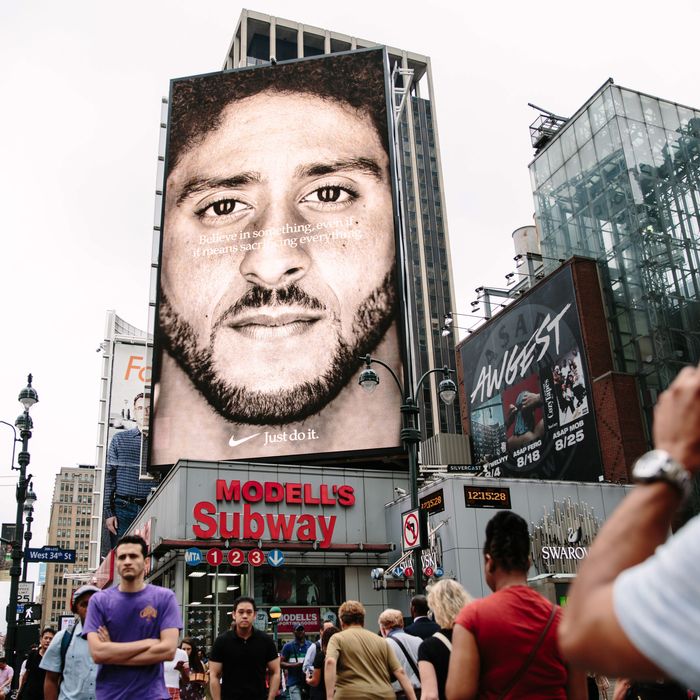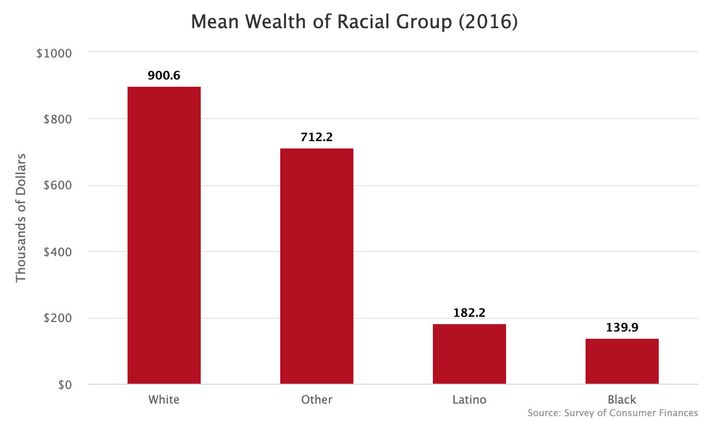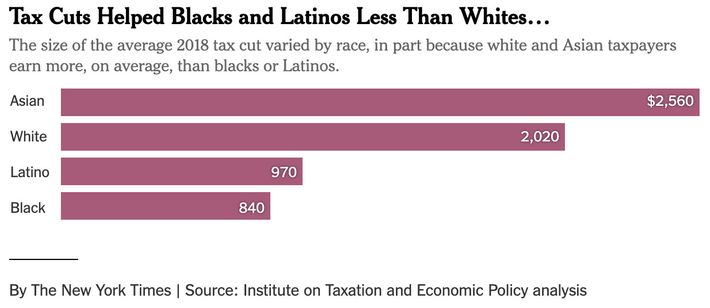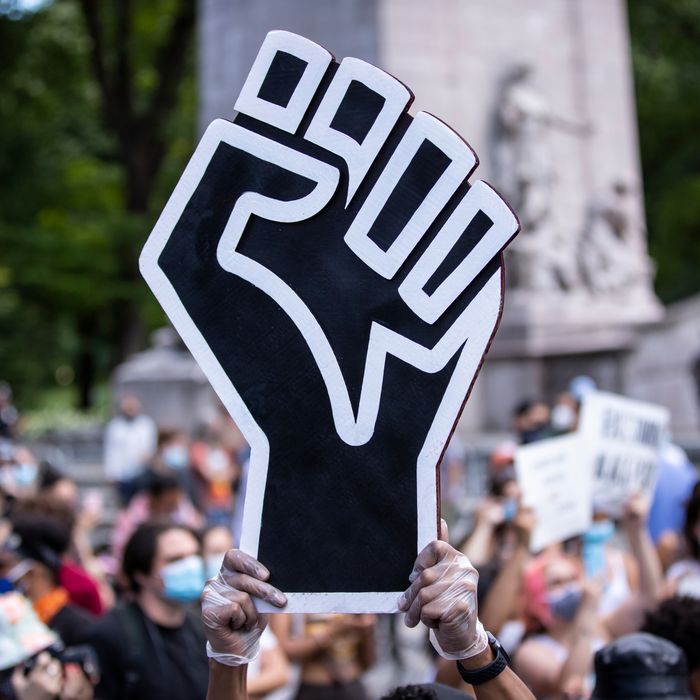Corporate America Loves Increasing Racial Inequality

Just stop increasing the racial wealth gap. Photo: Alba Vigaray/EPA-EFE/Shutterstock
At some indiscernible point in the recent past, uptight, lily-white corporate America left its segregated suburb for a liberal arts college, made one Black friend, read exactly five pages of The New Jim Crow, and returned wrapped in kente cloth.
Our nation’s top consumer-facing firms have been “woke” for a while now. But over the past three weeks of anti-racist protest, our brands have taken their allyship to the next level. Now, McDonald’s is cutting checks to the Urban League, Jeff Bezos is castigating white-supremacist Amazon customers over Instagram, and the Walton family is on the cusp of rebranding as the vanguard of the Third Reconstruction.
For some, the only thing more tiresome than the anti-racist gestures of tax-evading, union-busting corporations may be columns alerting the public to the shocking fact that those gestures are somewhat hypocritical. But calling attention to such hypocrisy has its social utility; the fact that these firms feel compelled to profess values that contradict their practices creates opportunities for changing the latter through pressure campaigns. If McDonald’s wants to align itself with the increasingly forceful and hegemonic progressivism of America’s most coveted consumer bloc (urban-dwelling young adults), then perhaps it will need to pay its workers a living wage or diversify its boardrooms.
Modest improvements in internal corporate governance are probably the best we can hope to extract from these companies. So it makes some sense to focus critiques of “woke capital” on firm-level hypocrisies. But it’s also worth noting that if we want to build an America that’s free of gargantuan racial inequalities, there is no alternative to radically rebalancing the distribution of wealth and income in our society. And our enlightened megabrands aren’t just uninterested in reducing our economy’s racial inequalities — they are enthusiastic advocates of policies that increase those inequalities.
America owes its Black residents a large and growing debt.
For most of U.S. history, the majority of African-Americans were effectively barred from accruing wealth. For centuries, the fruits of their forced labor were commandeered by southern slave masters and allied northern interests. Then Jim Crow laws, segregated labor markets, white-supremacist plunder, and discriminatory housing policy locked the bulk of the Black population out of the world-historic wealth-building opportunity that was America’s postwar boom. In the half century since the Civil Rights Act’s passage, we’ve made significant progress in eroding the ideology that undergirded this injustice. But we’ve made little headway on the injustice itself; in fact, for decades, we’ve been moving backward. Since the early 1980s, the Black-white wealth gap has grown larger.
This shouldn’t be surprising. In a capitalist society, wealth begets wealth; compound interest compounds initial inequalities in asset ownership. Thus, if you concentrate a nation’s capital into white hands for four centuries or so, merely preventing the racial wealth gap from growing, year upon year, will require a great deal of income redistribution — specifically, from those who own a lot of capital to those who own little.
The racial wealth gap is conventionally represented by the disparity between the net worths of the median white household and the median Black one. And this discrepancy is eye-popping. According to the Survey of Consumer Finances (SCF), the median white family was worth $162,800 in 2016, while the median Black family was worth $16,600. Other analyses suggest the actual gap is even larger.
And yet, as socialist wonk Matt Bruenig has noted, there’s something odd — and inherently misleading — about defining the racial wealth gap as the discrepancy between the holdings of the median white and Black household. After all, the vast majority of wealth in the U.S. isn’t owned by middling families but by rich ones. White households who occupy the median quintile of U.S. wealth distribution lay claim to just 3.7 percent of all white-owned wealth (for the median quintile of Black households, that figure is 2.8 percent). Thus, if we want to see the true scale of racial wealth inequality, we need a metric that doesn’t elide the primary driver of that inequality: The fact that an enormously disproportionate share of national wealth is concentrated in the hands of a predominantly white upper class.
One way to do this to calculate the average (or mean) wealth of each racial group. Under this accounting, using SCF data, the wealth gap isn’t $146,200 but $760,000.

Graphic: Survey of Consumer Finances/People’s Policy Project
As of 2016, closing the gap between the median white and Black households would have required a transfer of $456 billion. But equalizing the per capita wealth of America’s Black and white populations would require a transfer of $15.2 trillion.
In other words, conventionally measured, the wealth gap between white and Black America is large; accurately measured, it is gargantuan.
Most of the brands that pledged solidarity with Black Lives Matter this week studiously avoided condemning racial inequality, preferring instead to decry racial “injustice” and “inequity.” But money is power. And gargantuan, ever-growing disparities in power that are rooted in centuries of slavery and discrimination are straightforwardly unjust and inequitable. Furthermore, the kinds of racial inequities that corporate America is comfortable decrying — Black-white disparities in incarceration, victimization by police, and employment in coveted managerial positions — are inextricable from the wealth gap.
To be sure, we can (and should) make our society less racially unjust even if massive economic redistribution remains off the table. Straightforward anti-Black discrimination in housing and hiring remains prevalent in the U.S. We don’t need to become a social democracy to prosecute killer cops with greater frequency, or wait until the passage of reparations to reduce needlessly punitive and discriminatory criminal sentencing. Diversifying corporate boardrooms and legislative bodies is a poor horizon for progressive politics. But it’s better than nothing.
Unless one tackles racial inequality at its material root, however, progress on many of these fronts is liable to be limited.
To make C-suites more diverse, try making the economy less unequal.
It will be hard to fully redress the underrepresentation of African-Americans in elite corporate roles without increasing social mobility in the U.S.; and it is all-but impossible to significantly increase social mobility without reducing wealth inequality. Most research on social mobility measures changes in wealth or educational attainment between parents and children. For example, a 2014 study by economists at Harvard and Berkeley found fewer than 10 percent of those born into the bottom fifth of the wealth distribution make it into the top fifth. The middle class fared only slightly better — roughly 20 percent of those born into the middle fifth reached the top fifth by the end of their lives. (African-Americans are overrepresented on the bottom rungs of the wealth ladder, accounting for about 13 percent of the U.S. population, but 23.5 percent of the lowest wealth quintile.)
But those grim statistics actually overestimate the level of social mobility in American society. As Northwestern University’s Joseph Ferrie has argued, one must look at changes in class status over multiple generations to get a true sense of a society’s economic fluidity, “because there can be these one-generation blips that obscure the total amount of generational mobility.”
For example: If a rich banker’s son becomes a novelist, and then fathers a child who grows up to join the family business on Wall Street, this progression would register in the data as a testament to class fluidity. The novelist’s class privilege didn’t prevent him from earning far less than his parents, while his meager income didn’t prevent his daughter from ascending to the economy’s commanding heights. But these intergenerational fluctuations in income would mask a continuity in class position as measured by familial wealth. This hypothetical daughter likely drew on inherited resources and connections to move up the ladder, so her ascent testifies less to the mutability of America’s class hierarchy than its sturdiness.
Conversely, if a poor but exceptionally gifted African-American child rises into the upper-middle class, securing an enviable income and professional reputation, but amassing only modest wealth once she’s paid off her student loans and provided aid to her less fortunate family members, then there is a good chance her children may end up falling back down the ladder. After a single generational blip, her family would have thus resumed its traditional place in America’s economic order.
When economists and sociologists measure mobility across three generations, they do indeed find that there is even less movement between classes than conventional metrics indicate.
For this reason, if we want to expand the Black percentage of America’s upper-middle — and/or elite professional — class in a substantial and durable fashion, we need to, at the very least, redistribute an enormous amount of income from America’s (disproportionately white) rich to its (disproportionately Black) poor and working class.
Redistribution may be less of an inherent prerequisite for racial inequities in policing and incarceration. We can reduce sentence lengths and increase police accountability without reducing economic inequality. That said, in the present context, the overrepresentation of African-Americans in our prison population is inextricable from their overrepresentation among the poor. By certain measures, class disparities in imprisonment are even more profound than racial ones; in 2017, a white high-school dropout was roughly 15 times more likely to be incarcerated than a Black college graduate. If one wishes to increase racial equity in America’s criminal-justice system, then reducing racial inequality in America’s economy is among your safest bets.
Black lives matter. But for corporate America, tax cuts matter more.
Alas, McDonald’s, Amazon, Walmart, Nike, Google, Apple, and other companies that have recently pledged their allegiance to Black Lives Matter aren’t merely silent on the issue of the racial wealth gap, they are committed to increasing it.
The most gratuitous expression of “woke” capital’s bad faith may be its routine patronage of a political party led by a virulent racist who has publicly championed police brutality as a positive good. The same year that Nike made Colin Kaepernick its spokesman, the shoemaker gave the bulk of its campaign contributions to Republican candidates. This month, Google programmed its Assistant to respond to a hypothetical white consumer who suggests that “all lives matter” by noting, “Black lives are at risk in ways others are not.” And yet, in 2016, Google gave a majority of its campaign contributions to a party whose standard-bearer insisted that the Central Park Five should still be in prison, DNA evidence be damned.
But the problem here isn’t just that some “woke” corporations are willing to look past the nakedly racist aspects of Republican politics. It’s that essentially all such corporations are energetically supportive of Republican economic policies that deepen racial inequality.
Corporate America sent thousands of lobbyists to D.C. in 2017 to help tailor the Trump tax cuts and then facilitate their passage. In the years before that legislation’s enactment, Walmart and Nike helped fund Reforming America’s Taxes Equitably, an (Orwellian) advocacy organization dedicated to slashing America’s corporate tax rate.
Since the Trump tax cuts delivered the lion’s share of their benefits to (overwhelmingly white) corporate shareholders and business owners — thereby increasing capital’s share of income gains relative to labor — they had the effect of increasing Black-white economic disparities. As the New York Times has illustrated:

Graphic: The New York Times
All of which is to say: Corporate America’s dogged support for perpetually increasing wealth inequality through public policy does more to deepen racial inequity in the United States than any messaging campaign or diversity initiative could ever do to mitigate it.
